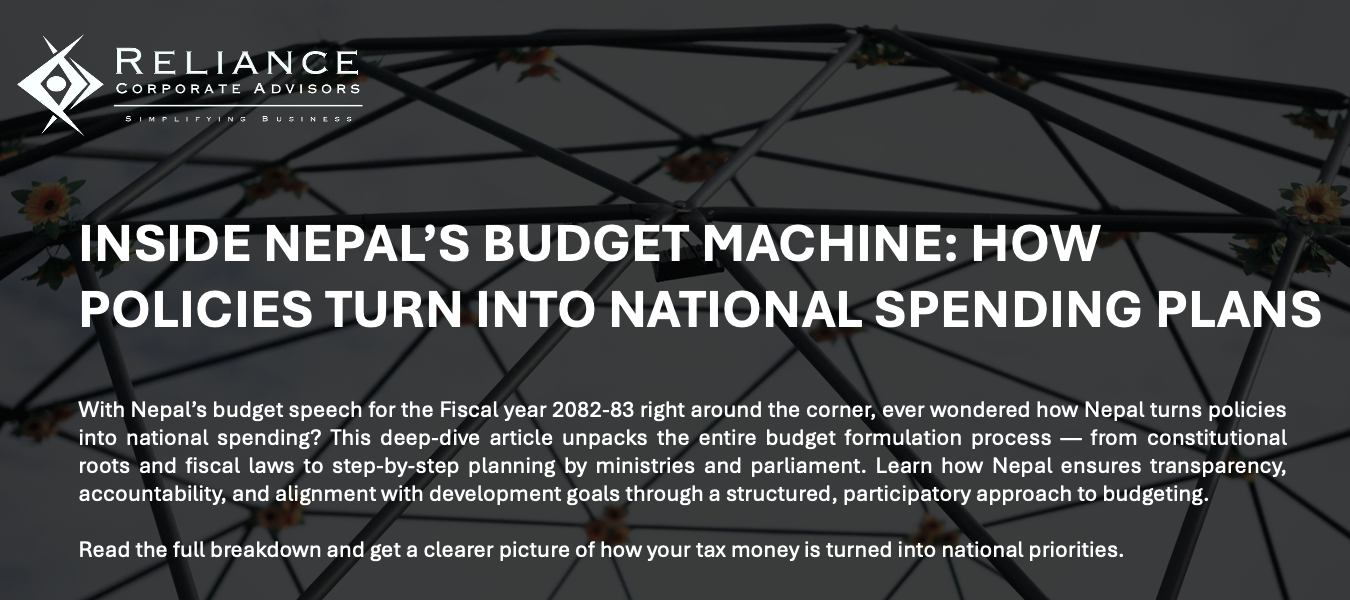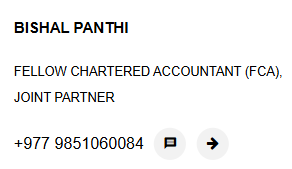
23 May 2025 | INSIGHTS
Government budget refers to a financial plan that estimates the government’s revenue and expenditures over a specified future period, typically one fiscal year. In the context of Nepal, the national budget is a vital instrument through which the government allocates public resources to achieve its developmental, economic, and social objectives.
It outlines how resources are distributed among various sectors such as education, health, infrastructure, and security, ensuring effective financial management and prioritisation of national goals. The budget serves not only as a financial blueprint but also as a policy tool for economic planning and governance.
In this article, we explore the formulation process of Nepal’s national budget, including the institutions involved, key stages, and guiding principles that shape how the country’s financial priorities are set each year.
CONTENTS
![]() COMPONENTS OF BUDGET & BUDGET SPEECH
COMPONENTS OF BUDGET & BUDGET SPEECH
![]() SOME MAJOR LAWS GUIDING BUDGET FORMULATION PROCESS
SOME MAJOR LAWS GUIDING BUDGET FORMULATION PROCESS
![]() THE BUDGET FORMULATION PROCESS
THE BUDGET FORMULATION PROCESS
![]() SUMMARY TIMELINE OF FORMULATION PROCESS
SUMMARY TIMELINE OF FORMULATION PROCESS
INTRODUCTION
A government budget in Nepal is a comprehensive financial statement prepared annually by the Government of Nepal, outlining the estimated revenues and proposed expenditures for a specific fiscal year. It serves as a critical instrument through which the government plans and manages the country’s economic resources.
The budget reflects the government’s fiscal policy, development priorities, and strategic plans for the upcoming year. It highlights how public funds will be mobilized and allocated across sectors such as infrastructure, education, health, agriculture, and social security, with the objective of promoting inclusive economic growth and sustainable development.
In Nepal, the budget also plays a key role in ensuring transparency, accountability, and good governance in the use of public resources.
TYPES OF GOVERNMENT BUDGET
Balanced Budget: A budget in which revenue equals expenditure is called a balanced budget. Such budgets are rarely practiced today, as it is often impractical to achieve a perfect balance between income and spending.
Surplus Budget: When the revenue exceeds expenditure, it is called a surplus budget. This concept is based on the ideas of classical economists, who believed that lower government spending and higher savings lead to economic stability. In Nepal, a surplus budget was presented only once, during the fiscal year 2033/034 BS (1976/77 AD).
Deficit Budget: A budget in which expenditure exceeds revenue is known as a deficit budget. The concept was introduced by British economist J.M. Keynes, who argued that during economic downturns, governments should increase spending to boost employment and accelerate development. After the great depression in the 1930s, this approach gained popularity. Today, most developing countries, including Nepal, regularly adopt deficit budgets to support their growth and development needs.
HISTORY OF GOVERNMENT BUDGET
The Chancellor of the Exchequer, Robert Walpole, presented the first-ever estimation of annual income and expenditure in the UK Parliament in 1733. This marked the beginning of formal budget presentation in history.
The institutionalisation of the budget developed gradually, with France starting in 1803 AD, India in 1860 AD, the United States of America in 1921 AD, and Russia in 1928 AD.
In Nepal, the first budget speech was delivered by then Finance Minister Subarna Shamsher on 19 Magh 2008 BS (2 February 1952 AD). The speech was broadcast via Radio Nepal.
The size of the 2008 BS budget comprises NPR 5 crore 25 lakhs in expenditure and NPR 3 crore 5 lakhs in estimated revenue.
COMPONENTS OF BUDGET & THE BUDGET SPEECH
Total Revenue and Its Sources: The total revenue and its sources include internal sources like taxes (income tax, VAT, customs, excise), non-tax revenues (fees, fines, dividends), and external sources such as foreign grants and loans.
Total Expenditure and Areas of Expenditures: The total expenditure and areas of expenditures includes recurrent expenditures (salaries, operations, subsidies), capital expenditures (infrastructure, development projects), and financing costs (interest and loan repayments).
A budget speech is a formal speech delivered by a government official, typically the finance minister to the parliament, presenting the government’s budget for the upcoming fiscal year.
Components of Budget Speech:
1. Economic Overview of the Country
2. Current Year Budget Review
3. Revenue and Expenditure Details
4. Policy Announcement
5. Fiscal Goal and Objectives
6. Rationale and Justification
CONSTITUTIONAL PROVISION
Part 10 of Nepal’s Constitution outlines the federal financial procedures, emphasizing the statutory regulation of tax collection, debt issuance, and governmental expenditures. The provision mandates that all taxes and loans must be authorized by law, and all government revenues, loans, and repayments be credited to the Federal Consolidated Fund. Expenditures from this fund require explicit legal authorization, with certain high-level governmental expenses being automatically chargeable without parliamentary approval. The finance minister is tasked with presenting annual and supplementary budget estimates to the Federal Parliament, ensuring transparency and accountability. Additionally, provisions for contingency and credit funds address unforeseen expenditures, underscoring the structured and lawful management of Nepal’s federal finances.
The Constitutional Provision Relating To Budget Presentation:
भाग १० धारा ११९. राजस्व र व्ययको अनुमान : (१) नेपाल सरकारको अर्थमन्त्रीले प्रत्येक आर्थिक वर्षको सम्बन्धमा संघीय संसदका दुवै सदनको संयुक्त बैठकमा देहायका विषयहरू समेत खुलाई वार्षिक अनुमान पेश गर्नु पर्नेछ। (क) राजस्वको अनुमान, (ख) संघीय सञ्चित कोषमाथि व्ययभार हुने आवश्यक रकमहरू, र (ग) संघीय विनियोजन ऐन बमोजिम व्यय हुने आवश्यक रकमहरू । (२) उपधारा (१) बमोजिम वार्षिक अनुमान पेश गर्दा अघिल्लो आर्थिक वर्षमा प्रत्येक मन्त्रालयलाई छुट्याइएको खर्चको रकम र त्यस्तो खर्च अनुसारको लक्ष्य हासिल भयो वा भएन त्यसको विवरण पनि साथै पेश गर्नु पर्नेछ । (३) नेपाल सरकारको अर्थमन्त्रीले उपधारा (१) बमोजिमको राजस्व र व्ययको अनुमान प्रत्येक वर्ष जेठ महीनाको पन्ध्र गते संघीय संसदमा पेश गर्नेछ ।
119. Estimates of revenues and expenditures: (1) The Minister for Finance of the Government of Nepal shall, in respect of every financial year, lay before the joint sitting of both Houses of the Federal Parliament an annual estimate setting out, inter alia, the following matters: (a) an estimate of revenues, (b) the moneys required to meet the charges on the Federal Consolidated Fund, and (c) the moneys required to meet the expenditure to be provided for by Federal Appropriation Act. (2) The annual estimate to be laid pursuant to clause (1) shall also be accompanied previous financial year and particulars of whether the objectives of the expenses have been achieved. (3) The Minister for Finance of the Government of Nepal shall lay before the Federal Parliament an estimate of revenues and expenditures under clause (1) on the 15th day of Jesta (mid May) each year.
SOME MAJOR LAWS GUIDING BUDGET FORMULATION PROCESS
Financial Procedures and Fiscal Responsibility Act, 2076: The Act is a foundational law that defines the framework for fiscal governance in Nepal, including budgeting, revenue management, and public finance accountability. This act aims to ensure fiscal discipline and establish a transparent budgeting process within government institutions.
Financial Procedures and Fiscal Responsibility Regulations, 2077: These regulations complement the Financial Procedures and Fiscal Responsibility Act by offering detailed instructions on the specific procedures to follow during budget preparation, including the timing, format, and documentation required.
Inter-governmental Fiscal Arrangement Act, 2074: The Act establishes the financial relationships between the federal, provincial, and local governments, specifying how funds are allocated and shared across these levels.
National Natural Resource and Fiscal Commission Act, 2074: This act establishes the National Natural Resource and Fiscal Commission, which is responsible for overseeing the equitable distribution of natural resource revenues and ensuring that environmental and fiscal policies are aligned with national interests.
National Natural Resource and Fiscal Commission Regulations, 2076: These regulations offer a detailed framework for the functioning of the National Natural Resource and Fiscal Commission, providing guidelines on how the commission should operate, how natural resource revenues should be allocated, and the types of reports and audits required.
THE BUDGET FORMULATION PROCESS
Policy Formulation and Medium-term Expenditure Framework (“MTEF”)
Nepal’s budget formulation process employs a hybrid of top-down and bottom-up approaches, ensuring coordination between national and local levels.
The Ministry of Finance (“MoF”) holds the primary responsibility for managing and executing the budget formulation.The process begins with a review of the previous fiscal year’s financial performance and a projection for the current fiscal year. Based on the review and projections, the relevant ministries/departments, the Ministry of Finance, and the National Planning Commission (“NPC”) collaborate to prepare preliminary budget projections for the next fiscal year. The MTEF Task Force within each ministry plays an active role. The NPC provides instructions on sectoral priorities and policy guidelines, ensuring a participatory and systematic process.
The MTEF is a rolling three-year budget plan, prepared annually. Each ministry develops its own MTEF, projecting expenditures aligned with sectoral policies and programs. These are submitted to the NPC and Ministry of Finance. The NPC then prioritizes projects and programs, defining a financial framework, estimated costs, timeframes, and expected results. Only projects with feasibility studies or detailed reports, or those listed in the Project Bank, are eligible for implementation.
Estimation of Fiscal Resources and determination of Expenditure Ceiling:
The National Resource Estimate Committee (“Resource Committee”) chaired by the Vice-Chairperson of the NPC, estimates available resources and sets expenditure ceilings for the next three years by 15th of Magh each fiscal year. The estimation includes resources across federal, provincial, and local governments, coordinated with the Ministry of Finance. This report is then submitted to the Ministry of Finance.
The estimates are aligned with MTEF, operational strategies, and policy updates to define a structured and realistic budget ceiling.
The resource committee considers macroeconomic trends, revenue forecasts, expenditure patterns, fiscal balance, and government policies.
Providing Budget Ceiling And Guidelines:
The Resource Committee’s ceiling is submitted to the NPC and Ministry of Finance for further allocation across recurrent, capital, and financing expenditures.
Ministry-wise ceilings and guidelines are then uploaded into the Line Ministry Budget Information System (“LMBIS”) and communicated to concerned ministries.
Ministries further distribute the budget ceilings internally to departments, district offices, and agencies through the LMBIS system.
Preparation Of Budget Proposal:
Ministries prepare internal budget ceilings and MTEF guidelines and pass them to subordinate offices within their jurisdiction.
These subordinate offices prepare detailed budget estimates and submit them back to the parent ministries via LMBIS.
Ministries review and consolidate the proposals submitted by field offices, finalize them with their own programs, and send the compiled proposals to the NPC and Ministry of Finance through LMBIS.
Discussion On Budget Proposal:
Budget discussions are conducted at the NPC, including participation from the Ministry of Finance’s International Economic Cooperation and Coordination Division, Budget and Program Division, and relevant line ministries. This process starts in the 4th week of Magh and ends by the 2nd week of Falgun.
Each ministry submits documents related to principles and priorities of the upcoming work programs to the Office of the Prime Minister and the Council of Ministers by the 3rd week of Falgun, to assist in preparing the President’s address to the Federal Parliament.
From the 4th week of Falgun, detailed deliberations continue on current, capital, and financial arrangements, involving the NPC Secretariat and relevant ministries. This phase ends by Chaitra-end.
Ministries then finalize and confirm budget ceilings, expenditures, and resource allocations, making revisions if required, in consultation with the Ministry of Finance.
Following these discussions, the Ministry of Finance drafts the budget in the first week of Baisakh, the policies and programs is presented by the President to the Parliament by the second week of Baisakh and the final draft of the budget is completed by the last week of Baisakh.
PRESENTATION OF BUDGET IN PARLIAMENT
Once the final draft of the budget is approved by the Council of Ministers, it is integrated with detailed estimates on revenue, foreign aid, loans, domestic debt, and other financial aspects.
The budget also incorporates the objectives, policies, strategies, and operational plans for the upcoming fiscal year as outlined by the Ministry of Finance.
On 15 Jestha (approximately last week of May), the finance minister formally presents the budget to the joint sitting of both the houses of the federal parliament.
The following major components are generally included in the budget presented in the Federal Parliament.
- Estimates of expenditure, broken down both by expenditure heads and funding sources
- Progress details specific to each ministry
- Medium-Term Expenditure Framework (MTEF)
- An overview of the national economy
- Performance indicators reflecting goal-oriented progress of government institutions
- Information regarding technical support
- Appropriation Bill
- Finance Bill
- National Debt Raising Bill
- Loan and Guarantee Bill
- Advance Bill
- Any additional matters as prescribed under the Inter-Governmental Fiscal Arrangement Act, 2074
SUMMARY OF FORMULATION PROCESS OF NEPAL BUDGET
| Due Date | Work Description | Agency/Ministry |
|---|---|---|
|
2nd week of Kartik (4th week of October) |
Estimate budget limits based on expenditure projections and consultations. | NPC, MoF, Relevant Ministries |
|
3rd week of Kartik(1st week of November) |
Prepare and present initial revenue projection. | NPC, Resource Committee |
|
2nd week of Mangsir (4th week of November) |
Set total national budget size and limits. | Resource Committee, NPC, Budget Division |
|
3rd week of Mangsir (1st week of December) |
Prepare and distribute ministry/department budget ceilings and guidelines. | NPC, MoF |
| 4th week of Mangsir (2nd week of December) | Share ceilings and guidelines with internal departments and projects. | Relevant Ministries |
| 2nd week of Poush (4th week of December) | Departments finalize and submit initial budget to LMBIS. | Relevant Departments |
| End of Poush (2nd week of January) | Departments submit budget drafts through LMBIS. | Relevant Departments |
| 1st week of Magh (3rd week of January) | Discuss and prepare budget with departments based on purchase plans. | Relevant Ministries |
| 3rd week of Magh (1st week of February) | Submit and verify final ministry-level budget in LMBIS. | Relevant Ministries |
| 4th week of Magh – 2nd week of Falgun (2nd week of February – 4th week of February) | Review detailed budgets covering operational, capital, and financial plans. | NPC, MoF, Relevant Ministries |
| 3rd week of Falgun (1st week of March) | Prepare prioritised budget and submit for national address. | Relevant Ministries |
| End of Falgun (2nd week of March) | Share and adjust revenue among federal, provincial, and local levels. | MoF, Fiscal Commission |
| 4th week of Falgun – End of Chaitra (2nd week of March – 2nd week of April) | Discuss overall budget including operations and fiscal policies. | MoF, NPC, Relevant Ministries |
| 1st week of Baisakh (3rd week of April) | Prepare draft budget. | Ministry of Finance |
| 1st week of Baisakh (3rd week of April) | Discuss budget policy and financial impacts in Parliament. | MoF, NPC |
| 2nd week of Baisakh (4th week of April) | Present policies and programs of budget to Parliament. | President |
| 3rd week of Baisakh (1st week of May) | Final discussion between NPC and MoF. | Finance Minister |
| 1st week of Jestha (3rd week of May) | Approve final budget and programs. | Finance Minister, NPC |
| 2nd week of Jestha (4th week of May) | Present implementation guidelines to Council of Ministers. | Finance Minister |
| 15th Jestha ( Around 4th week of May) | Deliver the official budget speech. | Finance Minister |
KEY CONTACTS
Drop us a mail at enquiry@reliancecs.co for more information on our work in this arena and your requests.





